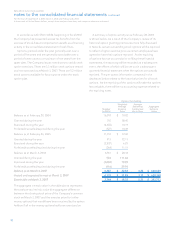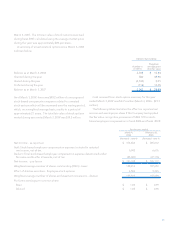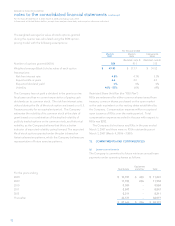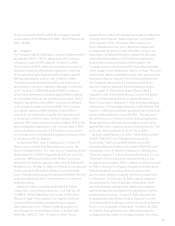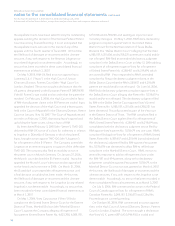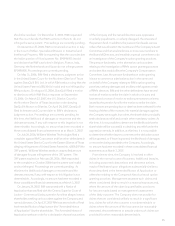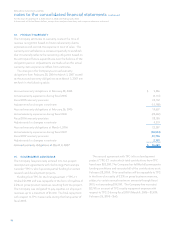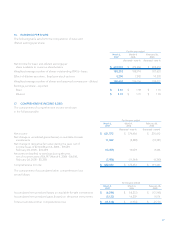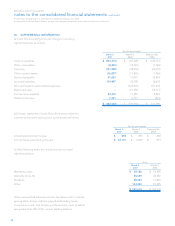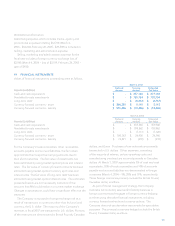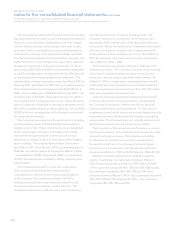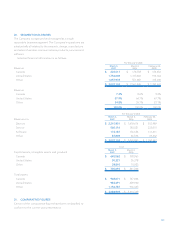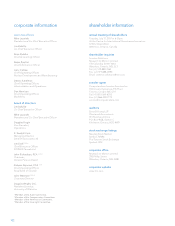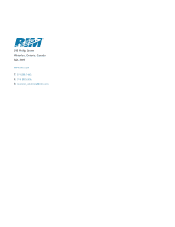Blackberry 2007 Annual Report Download - page 102
Download and view the complete annual report
Please find page 102 of the 2007 Blackberry annual report below. You can navigate through the pages in the report by either clicking on the pages listed below, or by using the keyword search tool below to find specific information within the annual report.100
RESEARCH IN MOTION LIMITED
notes to the consolidated financial statements continued
For the Years Ended March 3, 2007, March 4, 2006 and February 26, 2005
In thousands of United States dollars, except share and per share data, and except as otherwise indicated
The Company has entered into forward contracts to hedge
exposures relating to foreign currency anticipated transactions.
These contracts have been designated as cash flow hedges,
with the effective portion of the change in fair value initially
recorded in other comprehensive income and subsequently
reclassified to earnings in the period in which the cash flows
from the associated hedged transactions affect earnings. Any
ineffective portion of the change in fair value of the cash flow
hedges is recognized in current period earnings. For fiscal
years ending 2007, 2006 and 2005, the derivatives designated
as cash flow hedges were considered to be fully effective with
no resulting portions being designated as ineffective. The
maturity dates of these instruments range from March 2007 to
February 2010. As at March 3, 2007, the net unrealized loss on
these forward contracts was approximately $7,834 (March 4,
2006 – net unrealized gain of $24,868; February 26, 2005 – net
unrealized gain of $14,644). These amounts were included in
Accumulated other comprehensive income. These derivative
gains or losses are reclassified to earnings in the same period
that the forecasted transaction affects earnings. In fiscal 2008,
$3,598 of the net unrealized loss on the forward contracts will
be reclassified to earnings.
The Company has entered into forward contracts to hedge
certain monetary assets and liabilities that are exposed to
foreign currency risk. These contracts have been designated
as fair value hedges, with gains and losses on the hedge
instruments being recognized in earnings each period,
offsetting the change in the U.S. dollar value of the hedged
asset or liability. The maturity dates of these instruments
are in March 2007. As at March 3, 2007, an unrealized gain of
$542 was recorded in respect of this amount (March 4, 2006
– unrealized loss of $386; February 26, 2005 – unrealized loss
of $47). This amount was included in Selling, marketing and
administration.
The Company is exposed to credit risk on derivative
financial instruments arising from the potential for
counterparties to default on their contractual obligations
to the Company. The Company minimizes this risk by
limiting counterparties to major financial institutions and
by continuously monitoring their creditworthiness. The
Company’s exposure to credit loss and market risk will vary
over time as a function of currency exchange rates. The
Company measures its counterparty credit exposure as a
percentage of the total fair value of the applicable derivative
instruments. Where the net fair value of derivative instruments
with any counterparty is negative, the Company deems the
credit exposure to that counterparty to be nil. As at March 3,
2007, the maximum credit exposure to a single counterparty
was nil (March 4, 2006 – 46%).
The Company is exposed to market and credit risk on its
investment portfolio. The Company limits this risk by investing
only in liquid, investment grade securities and by limiting
exposure to any one entity or group of related entities. As
at March 3, 2007, no single issuer represented more than 9%
of the total cash, cash equivalents and investments (March 4,
2006- no single issuer represented more than 12% of the total
cash, cash equivalents and investments).
Cash and cash equivalents and investments are invested
in certain instruments of varying maturities. Consequently,
the Company is exposed to interest rate risk as a result of
holding investments of varying maturities. The fair value of
investments, as well as the investment income derived from the
investment portfolio, will fluctuate with changes in prevailing
interest rates. The Company does not currently utilize interest
rate derivative instruments in its investment portfolio.
The Company, in the normal course of business, monitors
the financial condition of its customers and reviews the credit
history of each new customer. The Company establishes
an allowance for doubtful accounts that corresponds to
the specific credit risk of its customers, historical trends
and economic circumstances. The allowance for doubtful
accounts as at March 3, 2007 is $1,824 (March 4, 2006- $1,551).
While the Company sells its products and services to a
variety of customers, two customers comprised 23% and
13% of trade receivables as at March 3, 2007 (March 4, 2006
- three customers comprised 18%, 13% and 13%). Additionally,
four customers comprised 19%, 14%, 11% and 11% of the
Company’s revenue (March 4, 2006 - four customers comprised
19%, 16%, 12% and 12%; February 26, 2005 - four customers
comprised 14%, 13%, 13% and 10%).


